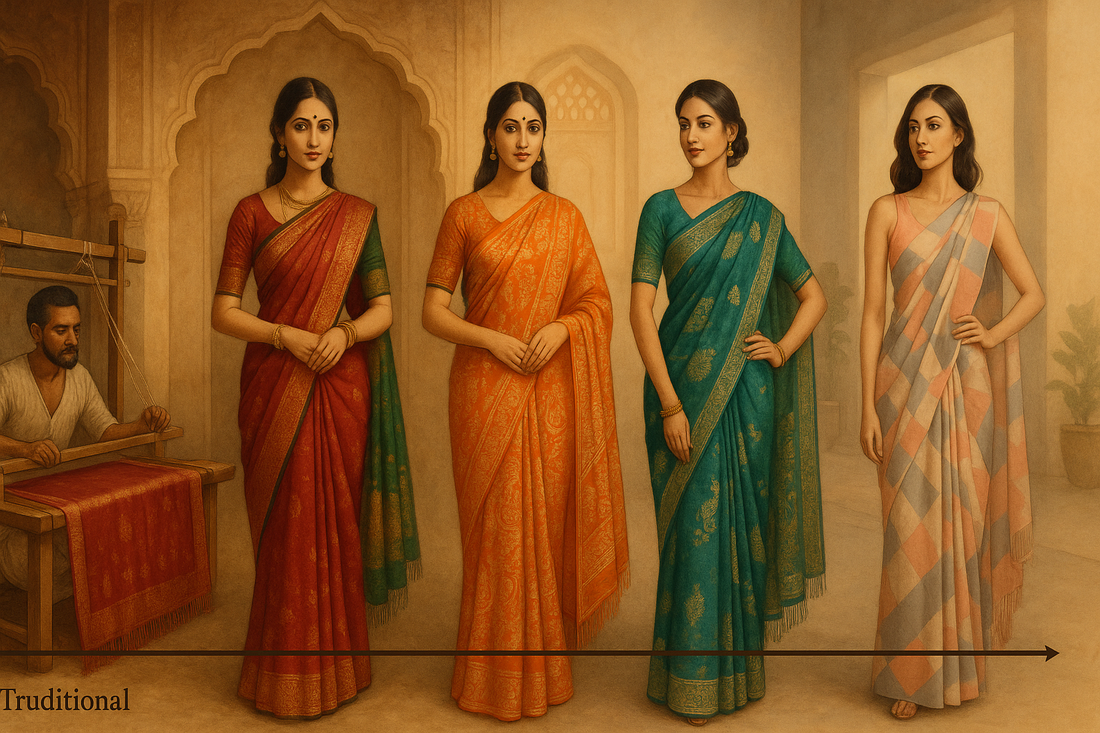
The History of the Saree: From Ancient Times to Modern Handloom Silk Sarees
Share
Handloom Silk Sarees The History of the Saree: A Trip With Time
Handloom Silk Sarees Couple of garments worldwide flaunt the type of tradition, sophistication, and advancement that the saree does. Woven right into the cultural and social textile of India, the saree is more than simply an outfit-- it's a symbol of heritage, a canvas of workmanship, and a timeless expression of feminineness. In this extensive blog site, we take you on a trip with the centuries, exploring the background of the saree, from its ancient roots to its place in the closets these days's fashion-forward ladies.
In the process, we'll explore exactly how designs like handloom silk sarees, printed saree published saree, and sarees latest sarees have evolved through time, especially via substantial social impacts like the Mughal Era, and just how designers today are restoring heritage with silk saree brand-new style concepts.
Chapter 1: Beginnings of the Saree-- Draped in Classical times
The story of the saree begins in the old people of the Indian subcontinent, dating back greater than 5000 years. The earliest depictions of draped garments comparable to sarees are found in the sculptures and texts of the Indus Valley Civilization (circa 2800-- 1800 BCE). Females of this age put on a lengthy item of unstitched towel covered elegantly around their bodies, paired with elaborate precious jewelry and hairstyles.
The word "saree" is originated from the Sanskrit word "śātika," implying a strip of towel. Early sarees were easy in layout but innovative in curtaining style. They were normally constructed from cotton, which was extensively grown in India. Handloom silk sarees came a lot later on, after the domestication of the silkworm and trade with China.
These early sarees had no shirt or petticoat. Women covered the saree in a way that covered the torso, flowing fluidly with their activity. It was an unstitched artform-- all-natural, cost-free, and versatile.
Chapter 2: The Evolution of Fabric-- From Cotton to Handloom Silk Sarees
As Indian human being advanced, so did the art of fabric making. The Vedic period (1500 BCE to 500 BCE) saw the introduction of brand-new weaving techniques, themes, and dyes. The saree came to be not just a garment but also a condition sign.
Silk ended up being a valued material throughout the Mauryan and Gupta empires. Trade with the Far East and Persia presented India to the appeal and luxury of silk. This resulted in the production of handloom silk sarees, which became a deluxe thing put on by royalty and upper class.
The saree became greater than simply everyday wear-- it was ritualistic, symbolic, and creative. Patterns influenced by nature, mythology, and day-to-day live were handwoven right into material. Each region of India started establishing its very own trademark style-- from the Chanderi sarees of Madhya Pradesh to the Kanjeevaram sarees of Tamil Nadu.
Phase 3: The Saree in the Mughal Age-- Deluxe Meets Virtuosity
The Mughal Period (1526-- 1857) was a transformative duration for Indian style. It was during this time around that India experienced an assemblage of Persian, Turkish, and Main Asian influences, specifically in fabrics and needlework.
While the Mughals themselves preferred streaming garments like the anarkali, their love for luxury deeply affected saree aesthetics. Fabrics ended up being richer, featuring zari (gold thread), brocade, and complex needlework. Silk saree brand-new design patterns took motivation from Mughal flower motifs, arabesques, and calligraphy.
This period likewise marked the start of sarees most current sarees in regards to craftsmanship. Weavers and artisans were funded by royal courts to create fancy sarees for queens and noblewomen. These layouts, many of which are maintained in museums and royal collections, form the basis of modern wedding celebration and joyful sarees.
Chapter 4: Colonial Influence and the Saree's Toughness
When the British (filled up with people or other living things) India, there was an attempt to (force (on people)/cause an inconvenient situation) Western fashion thoughts and feelings on the native population. However, the saree remained tough, changed (for improvement), and even changed (and got better) during this period.
The introduction of mill-made fabrics from Britain changed the availability and (ability to be easily paid for) of sarees. Machine-printed patterns became popular, giving rise to the printed saree printed saree part/section, which brought art and design to everyday wear.
Sarees were worn by educated Indian women of the early 20th century—as Naidu and Besant defined it—for cultural pride and resistance. The saree became a political and social statement. Beautiful, powerful and rooted in identity.
Phase 5: Post-Independence India and Regional Selection
After 1947, India saw a social renaissance. Regional saree customs were restored and celebrated. The Indian government urged handloom weavers and advertised indigenous weaves as part of the Swadeshi motion.
From handloom silk sarees in the South to Bengal's Baluchari and Jamdani, each area had a story to tell. Sarees came to be not simply a short article of clothes however an artifact of storytelling.
This period additionally brought to life the idea of saree collections-- festive, bridal, casual, workplace wear, and event wear. Style shows, movie theater, and television gave sarees a renewed identity.
Phase 6: Bollywood, Design Icons, and Sarees Most Current Sarees
Bollywood has really been instrumental fit the modern-day saree tale. Starlets like Madhubala, Rekha, Sridevi, and later on Deepika Padukone and Vidya Balan transformed sarees right into lavish style statements.
Movie motivated fads like chiffon sarees in rainfall scenes, glittering programmer silk saree brand-new format, and light-weight published saree released saree for everyday wear. The saree relocated from normal to stylish, situating an area in fashion runways and city wardrobes alike.
Programmers like Sabyasachi, Manish Malhotra, and Anita Dongre began including historical weaves with modern customizing. The outcome? Sarees newest sarees that are timeless yet contemporary.
Phase 7: Saree in the Digital Age-- E-commerce and Worldwide Reach
The 21st century has seen the saree adjust magnificently to the digital change. Today, handloom silk sarees, published saree printed saree, and silk saree new style alternatives are simply a click away on online platforms.
Indian and global buyers can discover sarees most recent sarees from throughout the nation without leaving their homes. Shopping has equalized saree fashion, enabling even remote weavers to showcase their art on a global platform.
Social media site platforms like Instagram and Pinterest have become design guides. Youthful influencers have actually made saree curtaining tutorials go viral, redefining just how millennials and Gen Z sight sarees.
Chapter 8: Rebirth Motions-- Commemorating Handloom Silk Sarees
The last decade has actually seen an aware resurgence of Indian handlooms. There is an expanding recognition for lasting style and moral production. This has actually brought about a rebirth in the appeal of handloom silk sarees and various other typical weaves.
Federal government programs, NGOs, and designer tags are sustaining weavers and restoring lost weaving styles. Customers are currently knowledgeable about the social worth and workmanship behind each saree.
Be it a Banarasi for wedding events, a Chanderi for festivals, or a Tussar for daily beauty-- every silk saree new layout becomes part of a living legacy.
Phase 9: The Modern Saree-- A Fusion of Custom and Trend
Contemporary sarees are everything about damaging the guidelines while valuing tradition. Designers are experimenting with pre-stitched sarees, pant-style sarees, coat blouses, belt accessories, and also saree gowns.
Sarees newest sarees include unconventional materials like fabric, lycra, and cells. Digital prints, abstract designs, and metallic weaves are obtaining appeal. Yet, in the middle of all this advancement, the love for published saree printed saree and handloom silk sarees continues to be unwavering.
Youthful professionals now put on sarees to the workplace. Brides are selecting individualized sarees that inform their tale. Fashion is ending up being a lot more comprehensive, with sarees offered for all dimensions, sexes, and age.
Phase 10: What the Future Holds-- From Silk Saree New Design to Global Style
As style comes to be more international, the saree is poised to end up being an international sign of slow-moving style, workmanship, and beauty. Brands are reimagining sarees for international runways, matching them with boots, coats, and modern devices.
The future of sarees depends on adaptability and sustainability. As more females seek purposeful style choices, handloom silk sarees and sarees most current sarees that incorporate society with convenience will blaze a trail.
Expect to see more silk saree brand-new design advancements-- like crossbreed materials, gender-neutral drapes, and also sarees integrated with tech (like LED-embedded sarees for stage efficiencies!).
Conclusion: A Six-Yard Legend of Design and Toughness
The saree is not just an item of fabric-- it is a canvas that carries tales, struggles, celebrations, and styles of millions of females throughout centuries. From the looms of old India to the ramps of Paris, from temple routines to digital reels, the saree has actually held up against the test of time.
Whether you're draping a printed saree printed saree for an informal day out or putting on handloom silk sarees for your wedding event, you are part of a classic journey-- a journey that honors the past while welcoming the future.
So, following time you put on a saree, bear in mind: you're not simply putting on a garment. You're wearing history.
